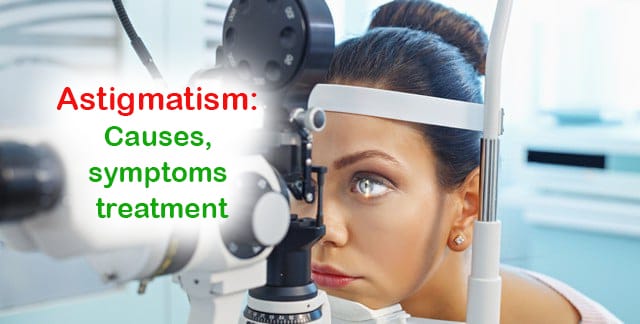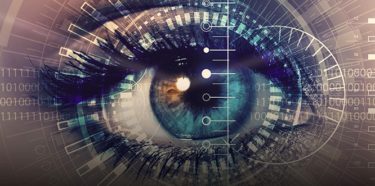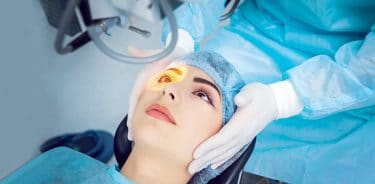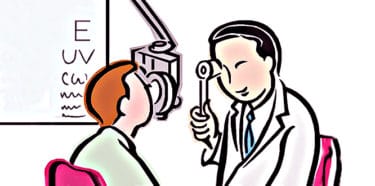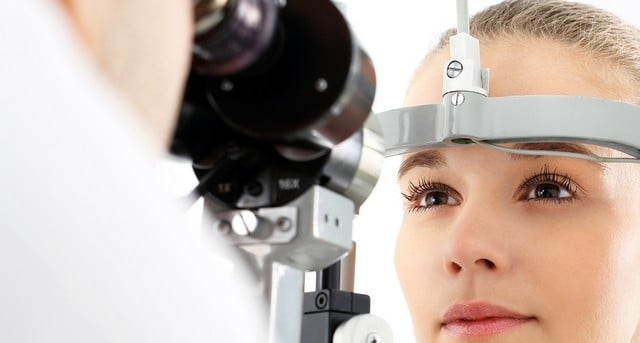
Table of Contents
What is astigmatism?
Normally cornea has a rounded shape and has equal diameters. Cornea of astigmatism patients is not rounded; instead it has an egg-like oval shape. The abnormal of the cornea means that the light entering the cornea will not be focused on a single spot on retina due to refractive error. This refractive defect in the eye leads to formation of two images on retina.
Although many people have minor degrees of astigmatism, most of them do not notice. However, patients with high degrees of astigmatism sees the surrounding objects blurred, distorted or shadowed. Generally 30-40% of all hypermetropia and myopia patients also have astigmatism.
Types of astigmatism
It has different types; myopic, hypermetropic and mixed astigmatism. In myopic astigmatism, image is focused in front of the retina and behind the nerve layer in hypermetropic astigmatism. And in mixed astigmatism, part of the image is focused in front of the retina and the other part is behind the retina.
Causes of astigmatism
It is usually caused by having an egg-shaped eye instead of a rounded shape. It means astigmatism is a result of irregular curvature of the cornea or lens and this is a genetic condition most of the time. However, sometimes it may develop after an eye surgery or an injury to the eye. On the contrary to the popular belief, reading books under low light conditions or watching television very close does not cause astigmatism.
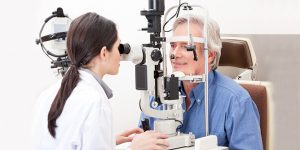
Individuals with vision conditions like astigmatism and kerataconus in their family have very high probability of developing it. People who had undergone an eye operation like cataract surgery may develop astigmatism afterwards.
Symptoms of astigmatism
- Blurred or distorted vision at all distances, whether far or near.
- Eye strain
- Squint
- Difficulty in night vision
- Eye irritation
- Headache
- Frequent hordeolum (stye) in the eye
- Long lasting eyelash inflammation
- Pain around the eye
- Double vision
Symptoms of astigmatism may vary among individuals. And sometimes there may be no symptoms at all. In case you have one or more of the abovementioned symptoms, you should consult an ophthalmologist.
Astigmatism test and diagnosis
Failure to diagnose and treat astigmatism in a timely manner could lead to amblyopia (lazy eye) in the future. Therefore, early diagnosis of it is very important. Although many people are born with astigmatism, they do not suffer any vision problems because of the low degree of it. And children with astigmatism generally do not complain about blurred or distorted vision. This may lead to unsuccessful results in their schools.
At that point it is very important to diagnose astigmatism in children at early ages in order to enable them to have success in their school and sports life. For diagnosis, you should first go to an eye doctor and have an extensive examination. Your doctor may perform many tests for astigmatism diagnosis.
Visual acuity test (vision test)
A vision chart containing various shapes and letters at a certain distance is used for visual acuity assessment. In visual acuity assessment test, one is closed and tested, and it is repeated for the other eye. This method determines whether the patient has any refractive defect in their eyes.
Refraction test
A machine called optical refractor with multiple corrective glass lenses is used during the test and, through the machine, your doctor monitors you as you look at graphs on the optical refractor. Refraction test can tell whether you see the letters on the graphic in a clear or blurred way.
Keratometry
Your doctor may check if there is any curvature in your eye to determine cornea curvature using keratometry. Cornea related diseases can be diagnosed using a keratometry device, which is utilized to measure radius of curvature and refractive power of the cornea. Keratometry devices can also be used for keratoconus diagnosis.
IMPORTANT NOTE: Keratoconus is thinning of cornea with advanced degrees of myopia and astigmatism. Although cause of this rare disease is unknown, these patients may not see objects clearly even when using glasses. Recurrent allergy and itching in eye, consistent progression of myopia and astigmatism and increased light sensitivity are most important symptoms of keratoconus.
For patients who are not diagnosed with hypermetropic, myopic or mixed astigmatism, and whose astigmatism is not developed after an eye injury or eye surgery, the cause of astigmatism is ‘keratoconus’!
Treatment of astigmatism
Corrective lenses
Your doctor may prescribe glasses or contacts for astigmatism that contain corrective lenses to prevent blurred, distorted or double vision caused by astigmatism.
Ortho-K contact lenses
Ortho-K contact lenses are used temporarily for treatment of irregular cornea curvature and they can be helpful for the treatment of astigmatism. These lenses are put on at night and removed in morning and patients can see all objects clearly throughout the day without needing contact lenses.
However, use of ortho-K lenses is a temporary solution to astigmatism as with glasses and contact lenses.
Surgical intervention
Lasers are used during the eye surgery aiming to reshape the cornea. However, since not all eye structures are suitable for laser operation cornea thickness is determined in a detailed eye test prior to the operation. Age of the patient, presence of any other eye condition accompanying astigmatism are among the factors that play a role in the determination of patient’s suitability for laser surgery.
During laser surgery, different laser methods like LASIK, LASEK, RK, PRK can be chosen depending on the eye structure and age of the patient. In our country, laser surgeries are generally performed by using LASIK or LASEK methods. LASER method is usually applied for patients whose eye structures are not suitable for LASIK surgery.
LASIK is a significantly painless method and patient’s eyes heal in a very short amount of time. Patients can get back to their normal lives as early as the next day. However, laser surgery must be performed by ophthalmologists that are experts in the field and by using modern laser devices.
If the patient has very high diopter that is impossible to correct with laser or the eye structure is not suitable for laser, implantable contact lens, ICL surgery, can be considered. Although implantable contact lens application is very common in Europe, very few doctors perform the procedure in our country.
Astigmatism surgery
As we mentioned before, surgery can be performed for the treatment of astigmatism depending on the suitability of the patient’s eye structure. In our country, the most common astigmatism operation is laser surgery. Laser surgery is classified as LASIK and LASEK. Excimer laser is used for both LASIK and LASEK.
Lasik surgery with astigmatism
LASIK surgery is more preferred by the doctors in comparison to LASEK because LASIK has a shorter recovery period than LASEK. Patients do not feel any pain during LASIK and they can see properly just a few hours after the surgery.
LASIK and LASEK surgeries are completed in a matter of several minutes. If the patient’s eye structure permits, LASIK Surgery is prioritized. In LASEK surgery, recovery may take up to 4-5 days. Therefore, people having LASEK surgery may need to rest for 1 week.
Generally antibiotics, corticosteroid-containing eyedrops are prescribed for the patient after laser surgery. Patients start to see clearly the next after the surgery. Success rate of laser surgeries is generally 98%.
Astigmatism surgeries are not performed for patients under 18 years of age. Because the corneal strength of such patients is yet to be fully matured. Generally glasses or contact lenses are preferred for treatment of patients under 18 years of age.
Differences between astigmatism and myopia
Astigmatism and myopia are genreally confused with each other, but they are two completely different eye conditions. While people with astigmatism see both near and distant object blurred, distorted and unclear, people with myopia have unclear vision for only distant objects. Myopic people have no difficulty in seeing close objects. On the other hand, people with astigmatism may have a blurred vision even for the object nearby.
Use of glasses in astigmatism does not cause any decrease or increase in the eye number, however, not using glasses for myopia may lead to rapid increase of myopia degree. Therefore, patients who cannot see distant object clearly should immediately see a doctor and start using glasses or contact lenses prescribed by the doctor.
Laser surgery can also be preferred in addition to glasses and contact lenses for the treatment of both diseases.
Diopter of astigmatism
Diopter of astigmatism is determined after a series of examination conducted by an ophthalmologist. Generally no intervention is needed for people with 0.50 D astigmatism.
Astigmatism between 0.50 D and 2.00 D can be treated with glasses and contact lenses. 3.00 D or greater diopter can be considered as advanced one. Generally laser surgery is evaluated in such case.
How do people with astigmatism see?
As the image is not completely focused on retina in an astigmatic eye, the image is reflected onto retina becomes blurred. Therefore, mildly blurred vision, severely blurred vision, double vision, distorted vision, shady vision, and distorted vision can occur in an astigmatic eye.
Depending on increased astigmatism diopter, more blurred and distorted vision takes place. In astigmatic people, pain around the eye and headache may develop depending on the degree of vision disorder.
How is astigmatism corrected?
It is generally a congenital visual disorder and can be temporarily corrected by using contact lenses or glasses. Meaning that patients can see the objects clearly as long as they wear their glasses or lenses.
However, glasses or contact lens use does not cure or treat it. Diopter of astigmatism will not change with glasses or lens use. Laser surgery is mandatory for complete recovery and correction of it.
Astigmatic glasses
Especially patients with up to 3 diopter astigmatism can eliminate their blurred and unclear vision complaints. However, using glasses does not lower the diopter of astigmatism, astigmatism is not cured by using glasses. Astigmatism glasses do not treat the disease; they just enable the patients to control the vision. In astigmatism treatment, glasses are only helpful when they are put on. The most accurate preference in astigmatism with diopter greater than 3.00 is laser surgery.

